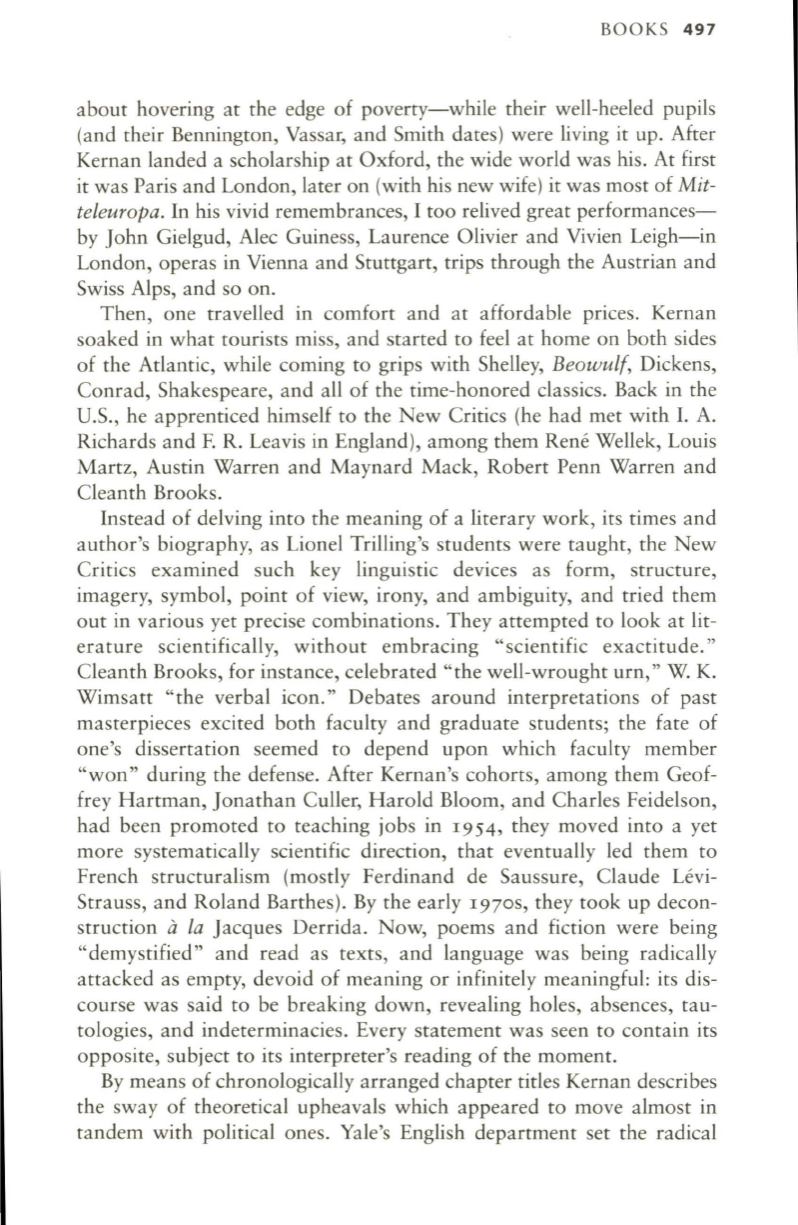
BOOKS
497
about hovering at the edge of poverty-while their well-heeled pupils
(and their Bennington, Vassar, and Smith dates) were living it up. After
Kernan landed a scholarship at Oxford, the wide world was his. At first
it was Paris and London, later on (with his new wife) it was most of
Mit–
teleuropa.
In
his vivid remembrances, I too relived great performances–
by John Gielgud, Alec Guiness, Laurence Olivier and Vivien Leigh-in
London, operas in Vienna and Stuttgart, trips through the Austrian and
Swiss Alps, and so on.
Then, one travelled in comfort and at affordable prices. Kernan
soaked in what tourists miss, and started to feel at home on both sides
of the Atlantic, while coming to grips with Shelley,
Beowulf,
Dickens,
Conrad, Shakespeare, and all of the time-honored classics. Back in the
U.S., he apprenticed himself to the New Critics (he had met with
I.
A.
Richards and
F.
R. Leavis in England), among them Rene Wellek, Louis
Martz, Austin Warren and Maynard Mack, Robert Penn Warren and
Cleanth Brooks.
Instead of delving into the meaning of a literary work, its times and
author's biography, as Lionel Trilling's students were taught, the New
Critics examined such key linguistic devices as form, structure,
imagery, symbol, point of view, irony, and ambiguity, and tried them
out in various yet precise combinations. They attempted to look at lit–
erature scientifically, without embracing "scientific exactitude."
Cleanth Brooks, for instance, celebrated "the well-wrought urn," W. K.
Wimsatt "the verbal icon." Debates around interpretations of past
masterpieces excited both faculty and graduate students; the fate of
one's dissertation seemed to depend upon which faculty member
"won" during the defense. After Kernan's cohorts, among them Geof–
frey Hartman, Jonathan Culler, Harold Bloom, and Charles Feidelson,
had been promoted to teaching jobs in 1954, they moved into a yet
more systematically scientific direction, that eventually led them to
French structuralism (mostly Ferdinand de Saussure, Claude Levi–
Strauss, and Roland Barthes). By the early 1970s, they took up decon–
struction
a
la
Jacques Derrida. Now, poems and fiction were being
"demystified" and read as texts, and language was being radically
attacked as empty, devoid of meaning or infinitely meaningful: its dis–
course was said to be breaking down, revealing holes, absences, tau–
tologies, and indeterminacies. Every statement was seen to contain its
opposite, subject to its interpreter's reading of the moment.
By means of chronologically arranged chapter titles Kernan describes
the sway of theoretical upheavals which appeared to move almost in
tandem with political ones. Yale's English department set the radical


